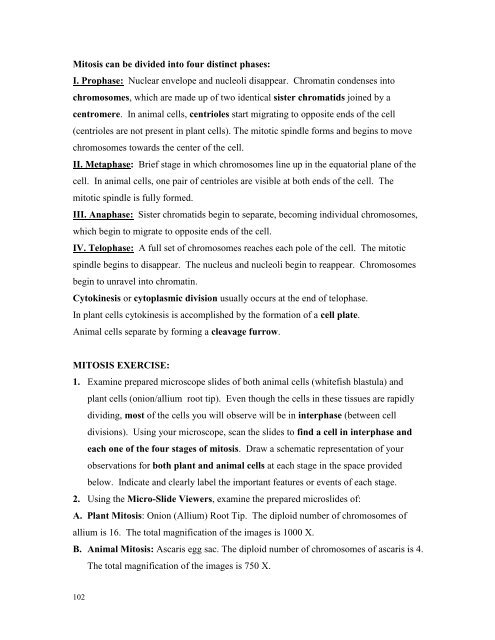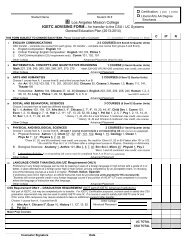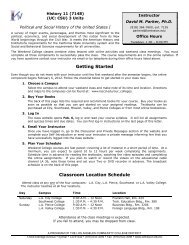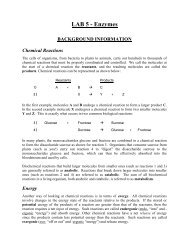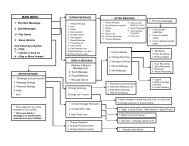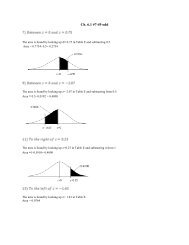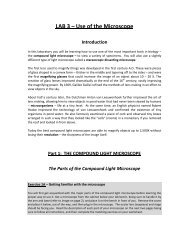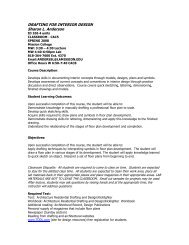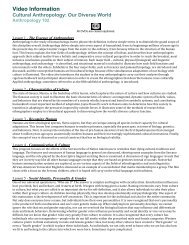eucaryotic cell division: mitosis and meiosis - Los Angeles Mission ...
eucaryotic cell division: mitosis and meiosis - Los Angeles Mission ...
eucaryotic cell division: mitosis and meiosis - Los Angeles Mission ...
Create successful ePaper yourself
Turn your PDF publications into a flip-book with our unique Google optimized e-Paper software.
Mitosis can be divided into four distinct phases:<br />
I. Prophase: Nuclear envelope <strong>and</strong> nucleoli disappear. Chromatin condenses into<br />
chromosomes, which are made up of two identical sister chromatids joined by a<br />
centromere. In animal <strong>cell</strong>s, centrioles start migrating to opposite ends of the <strong>cell</strong><br />
(centrioles are not present in plant <strong>cell</strong>s). The mitotic spindle forms <strong>and</strong> begins to move<br />
chromosomes towards the center of the <strong>cell</strong>.<br />
II. Metaphase: Brief stage in which chromosomes line up in the equatorial plane of the<br />
<strong>cell</strong>. In animal <strong>cell</strong>s, one pair of centrioles are visible at both ends of the <strong>cell</strong>. The<br />
mitotic spindle is fully formed.<br />
III. Anaphase: Sister chromatids begin to separate, becoming individual chromosomes,<br />
which begin to migrate to opposite ends of the <strong>cell</strong>.<br />
IV. Telophase: A full set of chromosomes reaches each pole of the <strong>cell</strong>. The mitotic<br />
spindle begins to disappear. The nucleus <strong>and</strong> nucleoli begin to reappear. Chromosomes<br />
begin to unravel into chromatin.<br />
Cytokinesis or cytoplasmic <strong>division</strong> usually occurs at the end of telophase.<br />
In plant <strong>cell</strong>s cytokinesis is accomplished by the formation of a <strong>cell</strong> plate.<br />
Animal <strong>cell</strong>s separate by forming a cleavage furrow.<br />
MITOSIS EXERCISE:<br />
1. Examine prepared microscope slides of both animal <strong>cell</strong>s (whitefish blastula) <strong>and</strong><br />
plant <strong>cell</strong>s (onion/allium root tip). Even though the <strong>cell</strong>s in these tissues are rapidly<br />
dividing, most of the <strong>cell</strong>s you will observe will be in interphase (between <strong>cell</strong><br />
<strong>division</strong>s). Using your microscope, scan the slides to find a <strong>cell</strong> in interphase <strong>and</strong><br />
each one of the four stages of <strong>mitosis</strong>. Draw a schematic representation of your<br />
observations for both plant <strong>and</strong> animal <strong>cell</strong>s at each stage in the space provided<br />
below. Indicate <strong>and</strong> clearly label the important features or events of each stage.<br />
2. Using the Micro-Slide Viewers, examine the prepared microslides of:<br />
A. Plant Mitosis: Onion (Allium) Root Tip. The diploid number of chromosomes of<br />
allium is 16. The total magnification of the images is 1000 X.<br />
B. Animal Mitosis: Ascaris egg sac. The diploid number of chromosomes of ascaris is 4.<br />
The total magnification of the images is 750 X.<br />
102


